�
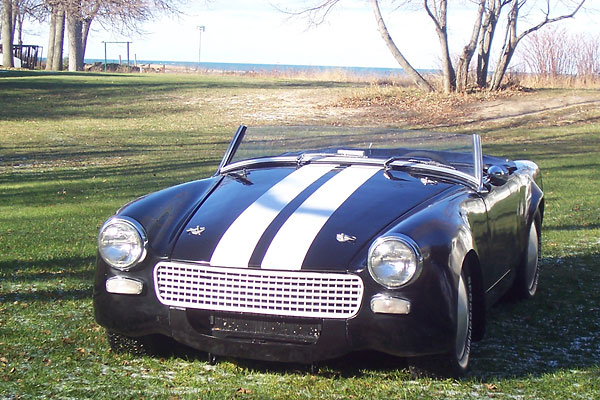 �
�
Rick Bondy's Zetec Powered 1961 Austin Healey Sprite
� as published in BritishV8 Magazine, Volume XVII Issue 1, July 2009�� Owner: Richard Bondy
� BritishV8 UserID: rickbondy
� � City: Northville, MI
� Model: 1961 Austin Healey Sprite (MkII)
� Engine: Ford 2.0 liter "Zetec"
� Conversion performed by: owner�
Saga of the Zetec Sprite
��
In 1992 our family was building a second home. There were plenty of cars, �
both old and new, and I was doing everything possible to avoid another �
automobile purchase. I was pounding nails; not spinning wrenches. �
I was buying construction materials, rather than car parts. Of course the �
inevitable happened and I purchased another project that could not be �
justified to anyone, not even myself. A medical doctor who lived next �
door to my father decided to end his SCCA racing career. �
�
The car was a 1961 Sprite Mark II, built to compete in SCCA's "H-Production" �
class. A fresh 948 cc engine had just been returned from the engine builder �
and was still in the wooden crate. The Sprite had been raced since 1977 and �
all of the original metal was in superb condition with the exception of the �
front fenders that had been involved in way too much nudging to be saved. �
The price was reasonable. We pushed the race car into my father's garage.�
�
The plan to let the car sit vanished within a couple of days and it was �
suddenly all over the driveway. We decided to restore the car with a �
minimum number of modifications: just enough to drive the Sprite on the �
street. At that time, our two daughters were teenagers and we thought �
the Sprite might provide a great opportunity for the kids to drive an old �
sports car through the rural area around our vacation home. It would �
be a very inexpensive project. If the car incurred a little damage here or �
there the world would not fall apart.�
�
The Sprite was stripped to bare metal, and new fiberglass rear fender �
flares, front fenders, and hood (all from Winner's Circle) were fitted.�
We painted the car in black lacquer. The Sprite looked pretty dull in black �
without any chrome trim, so a white racing stripe went over the top. �
BR60x13 radial tires went on Vega 5 inch wheels and they were covered �
in Moon full wheel hupcaps. Cobra seats, lights, and all of the required �
stuff just fell right into place. We installed a Painless hot rod wire kit �
(#90501), and decided to locate the fuseblock inside the trunk on the �
bulkhead. �
�
The car now looked great, but the "full race" motor had an unacceptable idle �
and shifting at 9,000 rpm didn't suit driving in the real world (even in an �
area with little more than mother nature's critters!) We quickly moved �
into "Phase Two".�
�
The next major step was to attempt to civilize the motor. The full race �
cam was replaced by an autocross spec unit and a different cylinder head was �
substituted to reduce the compression ratio. Predictably the car became �
somewhat easier to drive - but it still wasn't much fun. It had high rpm �
power, but not enough torque! The little 948cc was somewhere between stock �
and full race. It made plenty of noise but the car didn't accelerate as well �
as we hoped. The rear axle ratio was changed from 4.22 to 4.55 to one - �
and then back to 3.72 to one. All in all, it really didn't change the prognosis.�
�
Although Phase One and Two had transpired with reasonable speed, Phase �
Three would require more substantial investment in both time and money. I �
was employed at the Ford Motor Company at this time, and I developed an �
interest in potentially installing a Ford Zetec 2.0 liter engine in the tiny �
Healey. Cosworth Engineering had originally been involved it the engine's �
design. It was very robust and it could be modified up to 250 horsepower. �
Although peak power usually occurs at 6,000 rpm, it could be spun up to �
7,100 rpm. The motor has double overhead cams and four valves per cylinder �
in an aluminum head. The Zetec was manufactured in both England and �
Germany, in various displacements from 1.3 to 2.0 liters, and it was installed �
in Ford products around the globe. Here is the US it was used in the �
Contour, Cougar, and Focus. With wide applications in the US, the wrecking �
yard prices for complete low mileage examples are cheaper than purchasing �
a single performance part for some other makes. (Typical recycler prices range �
from $400 to $1,250.) On the other hand, one can purchase a complete, new �
"SVT" (Special Vehicle Tuning) engine from Ford.�
�
One negative of the Zetec engine is that it was always installed by Ford �
in an "east /west" (transverse) configuration for front wheel drive products. �
The engine cants rearward at approximately a 7.5 degree angle to allow for a �
low hood line and increased vision line to the pavement ahead. Thus, the oil �
sump and oil pickup assembly aren't really well suited for a rear wheel drive �
application. There are no side motor mounts, and the engine attaches at the �
front through the serpentine belt.�
�
These issues can all be overcome, I knew, because various "Super Seven" �
derivatives utilize the Zetec engine. The next step was to visit Great Lakes �
Caterham in Milford, Michigan. The owner Jim Constas assisted me in measuring �
various configurations. I came to the conclusion that with modifications �
the motor might fit, but it was going to be very close. I decided to purchase �
a Zetec engine and give it a try. If everything failed, my fallback position �
would be to use the engine in a Super 7.�
�
My 2.0 liter Zetec was removed from a wrecked 1999 Cougar with 11,642 �
miles. The difference between the automatic and manual motors are the �
ignition trigger sensor (flywheel-mounted tone wheel) and the length of �
the pinion on the starter motor.�
�
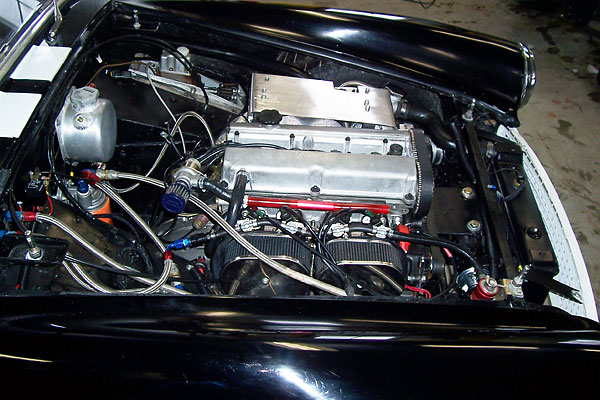
�
�
Many Super Sevens use a Borg Warner T9 transmission. (It's sometimes referred to �
as a Ford "Type 9".) The T9 is a 5-speed manual transmission with overdrive. In �
North America the Borg Warner T5 5-speed is more common and inexpensive because �
it was used in many more cars including both Mustang and Camaro, but there are �
advantages to choosing the T9. The T9 was originally a four speed unit that was �
subsequently redesigned with an additional overdrive ratio in a larger tailshaft �
housing. Subsequently, it's a very narrow package. It easily fits in the �
extremely narrow Sprite transmission tunnel. Unfortunately the only T9 product �
imported into the U.S. market was the Merkur. The T9 was widely used in Ford �
products throughout England and Europe.�
�
The T9 transmission had different gear ratios for four and six cylinder �
applications, and different input shafts too. The six cylinder versions are �
generally more suitable for performance applications, due to gear ratios. �
I purchased mine from Caterham. (It has the following ratios: 1st = 3.36:1, �
2nd = 1.81:1, 3rd = 1.26:1, 4th = 1.00:1, 5th gear 0.82:1.)�
�
To install the transmission, I purchased everything need from the Morris �
Minor Center in Birmingham, England. This included the drive shaft �
(29.25 inches), speedometer cable, cross-member, and various bits of �
incidental hardware. Everything came with great instructions, and the �
installation was quite simple. This was in early 2001 and by now these �
items are available through various vendors in the U.S. A new speedometer �
cable hole was drilled in the side of the transmission tunnel, and the top �
of the tunnel was enlarged just in front of the shifter location to �
compensate for the increased height of the tailshaft. A new tunnel cover �
and boot were fabricated and the shifter was shortened. The shifter location �
is perfect. �
�
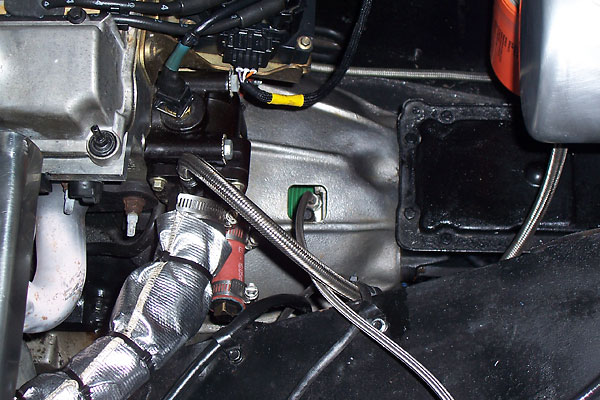
�
�
My order to Caterham included an alloy bellhousing, clutch and flywheel �
kit, sump kit, and many other items included in their basic Zetec �
installation kit for a Caterham. For the Sprite many items from this �
kit were not utilized, plus I went back and purchased other Caterham �
pieces along the build process.�
�
The Caterham alloy bell housing and clutch pieces include a number of �
fabricated pieces to utilize an annular clutch bearing (aka: HTOB or "hydraulic �
throw-out bearing"). For the Sprite, this is terrific since very little �
space exists for a clutch release arm. I found out the hard way after two �
annular release bearing failures (motor removal) that the capacity of the �
stock Sprite clutch master cylinder exceed the hydraulic capacity of the �
release assembly. I've finally determined the exact distance the clutch �
pedal can travel without blowing the bearing seal, and I've fabricated �
a pedal-stop on the floor. Finally no more clutch failures! Looking back, �
this was one of the most frustrating events during the development mileage.�
�
The Zetec motor won't fit without some custom fabricating - but with �
careful modifications to accomodate engine placement I was able to get �
the engine low enough that the hood would close. The Sprite features a �
unibody chassis with frame extensions in the engine compartment area. The �
frame extensions are stamped sheetmetal with a spot welded flange. This �
flange interfered with the width of the Raceline sump assembly which had �
been purchased through Caterham. I cleaned and folded the small flange over. �
Seam sealer and paint completed the modification. The pan will just fit �
between the rails. The oil drain plug is on the passenger side of the �
pan. Once the installation is completed, you'll just be able to loosen �
the drain. If you want to remove it completely you'll have to loosen �
the engine mounts and slide the motor towards the driver's side. �
�
The cast aluminum sump is quite short and allows the engine to fit under �
the hood. The engine oil filter will not fit and a remote oil filter was �
installed on the cowl. With a Fram HP-1 filter, the oil capacity is 5.75 quarts. �
I found that 5w30 oil really does work best. 20w50 racing oil creates �
extreme pressure.�
�
The next step to fit the motor between the main rails is notch in both rails �
about 4 inches long and a half inch wide and tall. This notch was subsequently �
boxed-in with 1/8 inch angle iron. This allows the bell housing to sit low �
enough between the rails and insure a proper relationship between the tailshaft �
and the differential pinion.�
�
There is a chrome moly round tube roll bar under my Sprites instrument panel. �
The tubing extends from the floor up behind the dash and terminates again at �
the floor. From each side main front frame rail at the suspension pickup �
point tubing extends rearward and ties into this hoop. All of the remaining �
SCCA tubing was removed and the car is amazingly rigid.�
�
The main front cross member which ties the frame rails together and serves �
as the mount for the steering rack was permanently removed. This was required �
since there is not enough room for the Zetec oil pan and crank pulley. The �
new crossmember was puts the steering rack in an ideal position to avoid bump �
steer, and also locates the front motor mounts and the radiator. It is generally �
box-like in shape, with the top sloped at 7.5 degrees to mount squarely to �
the front to the motor. It was designed to be removable; it simply bolts to the �
frame extensions. The motor and transmission are removable now by sliding �
them forward on dolly once the crossmember is unbolted. No more lifting! �
Caterham rubber motor mounts were used along with a custom steel bracket �
which attaches through the center of the serpentine belt.�
�
To keep the serpentine belt rotating correctly, an idler pulley and billet �
bracket were purchased from Caterham. A Caterham radiator was also used. �
A miniature single wire alternator was attached using fabricated brackets.�
�
There's little room between the engine block and the steering shaft, so I �
used a Ford Focus exhaust header. The four tubes sweep upward and then join into �
a collector allowing sufficient space. I used 1 7/8 pipe for the remaining �
exhaust system. Because of the proximity of the header to the hood, I �
used a stainless steel heat shield over the header and also installed an �
aluminum multi-layer blanket to the underside of the fiberglass hood.�
�
The most difficult part of the conversion was the engine management system. �
For years I attempted to use the Ford ECU and harness. I considered every �
option I could research. Eventually I purchased a complete Alpha Gold System �
from Webcon UK (www.webcon.co.uk). This kit supplies absolutely everything �
you'll need. �
�
The main features are Webers modified for port fuel injection, ECU, and �
entire engine harness. All of the numerous components are original equipment �
quality and the entire kit was labeled and came with the best installation �
manual I've ever seen. �
�
Webcon UK does not have any US dealers although 57 of the above kits were �
installed on Superformance S1's which were sold here. I spoke at length were �
their sales and engineering director prior to my purchase. The stock motor �
grows from 135 hp to 171 hp with this kit according to dyno tests. I did �
some serious porting and polishing of the intake manifold and coupled with �
my exhaust header 175 to 180 hp is probably a conservative estimate for �
my engine's performance. This is a costly investment, but knowing what I know �
now I wouldn't entertain any other course of action.�
�
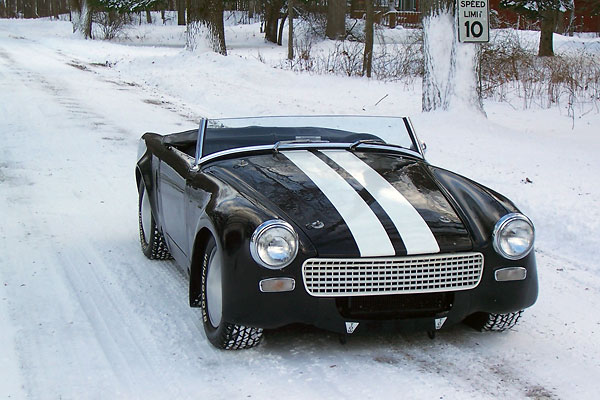
�
�
The Michigan climate provides weather extremes, but the modern electronic �
fuel injection system can't be beat for starting, idling and running in all �
conditions. I have all of the wonderful handling attributes of an H-Production �
Sprite racecar with the engine performance of a very hot modern sports car. �
180 HP divided into 1,450 pounds is a little over 8 pounds per horsepower. �
A 4,000 pound car would require about 497 hp to run with my little Sprite.�
�
I'm currently using the 3.72 ring and pinion which is a great street combination �
with the T9 transmission. 60 mph can be reached without leaving second gear �
(at 6,000 rpm). Top speed at 6,000 rpm is estimated at 133mph. At 6,600 rpm, �
the car could be 146mph.�
�
The stock Sprite speedometer only goes up to 100 mph. I destroyed mine in short �
order, and subsequently fitted an MGB speedometer which registers to 120 mph. �
�
At the completion of the project I achieved my major goal of keeping the weight �
of the Sprite at 1,450 pounds and thus not diminishing the balance, steering �
feedback, or road holding.�
�
Knowing what I know today I would describe this conversion as quite "do-able" �
for most garage freaks. The amount of cutting of the Sprite's bodyshell was �
relatively minor. The final outcome greatly exceeds my initial expectations. �
Boy, how 16 years can blow by!�
�
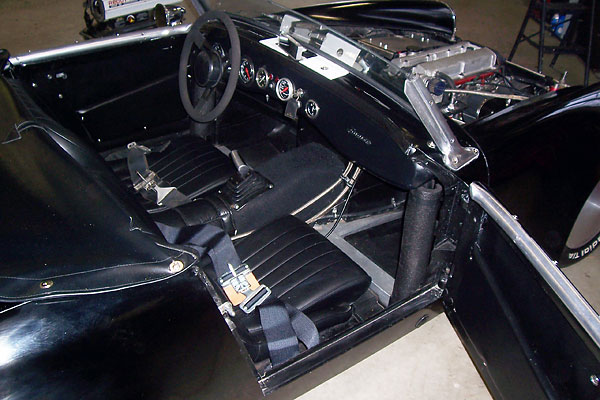
�
How It Was Done
�| Engine: | �Ford "Zetec" 2.0L DOHC 4-valve-per-cylinder (1999 Mercury Cougar) �
with Webcon "Alpha Gold" induction and engine management system �
(PN: K20016 - ECU & port fuel injection).�
Engine redlines at 6,000 rpm, Rev-limiter (in ECU) is set for 6,600 rpm. �
45mm throttle bodies. Pico fuel injectors. Stock Ford camshafts. �
(Note: the servo for variable exhaust timing has been disabled.)�
Raceline (5.75 qt) low-profile, cast aluminum oil pan with windage tray. �
Fram HP-1 remote oil filter with Aeroquip braided lines. �
Lotus engine idler system and serpentine accessory drive belt. �
High output one-wire mini alternator mounted on custom brackets. | �
| Cooling: | �Caterham "Super 7" radiator and electric fan. Spun aluminum coolant �
overflow tank. | �
| Exhaust: | �modified Ford Focus header, stainless heat shield, and custom �
(1 7/8") straight flow exhaust system. | �
| Fuel system: | �ATL Fuel Cell, filler foam, and anti-tip valve. Aeroquip fuel �
lines including return circuit. Inertia switch for the fuel pump �
is located in passenger's footwell. (Note: safety foam in the fuel �
cell prevents use of a lever-arm fuel sensor, but it also dissipates �
returned fuel. If the foam were removed, a swirl pot will be required.) | �
| Transmission: | �new Borg Warner (Ford) T9 5-speed transmission (as used in the Sierra �
and Merkur, 1st:3.36, 2nd:1.81, 3rd:1.26, 4th:1.00, 5th:0.82, R:3.87.)�
Lotus bell-housing. Annular (HTOB) clutch release (Ford PN: F5RZ-7A508-B). �
Caterham lightweight flywheel, heavy duty clutch, & pressure plate. �
Custom driveshaft (29.25" long) with safety hoop. Clutch master cylinder �
has been re-sleeved in stainless steel. | �
| Rear Axle: | �stock axle with 3.72:1 gear and open differential in aluminum carrier. �
(Current ratio will get car to 60mph in second gear. 4.22 and 4.55 gears �
are kept in reserve.) High strength axle shafts. New bearings and seals. | �
| Front Suspension: | �reduced height racing coil springs. Adjustable bushings for setting camber. �
(Currently running about 2 degrees of negative camber.) 7/8" roll bar. | �
| Rear Suspension: | �offset racing-spec leaf springs. Rose jointed radius arms. Custom Panhard bar. | �
| Wheels/Tires: | �Chevrolet Vega 13x5, 4-on-4", 0.20" offset, steel wheels with �
BF Goodrich "Radial T/A" 205/50 tires. Oversized wheel studs �
and 0.25" aluminum spacers. | �
| Brakes: | �(front) Sprite MkIII front disc brakes. � (rear) stock drum brakes. � Master cylinder has been re-sleeved in stainless steel. Aeroquip brake hoses. | �
| Chassis: | �main frame rails have been modified for increased width. A cowl hoop is hidden �
under the instrument panel, with diagonal supports running forward from �
it to the front subframe (all constructed from chrome-moly steel tubing.) �
Custom front crossmember with Caterham motor mounts and revised steering �
rack location. Custom transmission crossmember and modified tunnel. | �
| Body: | �fiberglass front and rear fenders with large flares. Mark I doors �
(no window mechanisms). Reinforced fiberglass hood (mounted on pins.) �
Original floor and trunk (no rust). Custom aluminum rear bulkhead.�
Bumpers removed and bumper holes filled. All chrome trim removed.�
Front valance with enlarged air intake. Chopped windshield (4.5").�
PPG lacquer (no clear coat). White stripes (tape). | �
| Interior: | �fiberglass instrument panel with Stewart Warner gauges except for �
a Smiths speedometer from an MGB (with 120mph top speed instead of �
100mph). Cobra bucket seats with Simpson competition seat belts. �
Race steering wheel with chest pad. �
Custom armrest, carpet, and rubber mats. Aluminum floor trim.�
Fire extinguisher. | �
| Electrical: | �ECU is located under the instrument panel on the passenger's side. �
Painless wiring system (PN: 90501) installed with fuse panel in the trunk. �
Trunk mounted battery. Battery tender. Exterior-mounted master cut-off switch. | �
| Weight: | �1,450 pounds (wet) - approximately 8# per horsepower! | �
| Performance: | �approximately 175-180hp at the wheels. (Webcon dyno-tested the �
engine before installation of the current exhaust header, and before �
porting and polishing of the intake manifold. It was at 172hp in that �
configuration.) | �
| Completed: | �June 2006. | �
| Comments: | �From 1977, this car was SCCA "H-Production" race car. (It was purchased �
by Richard Bondy in June 1992.)�
� A modern multi-port fuel injection system with a custom programmed ECU � is the only way to go if you want your Sprite to perform perfectly each � and every day. It's wonderful never having to make excuses. This was my � first Sprite conversion; the next one could actually be quite painless. � Try it, you will like it! | �
Engine Installation
��
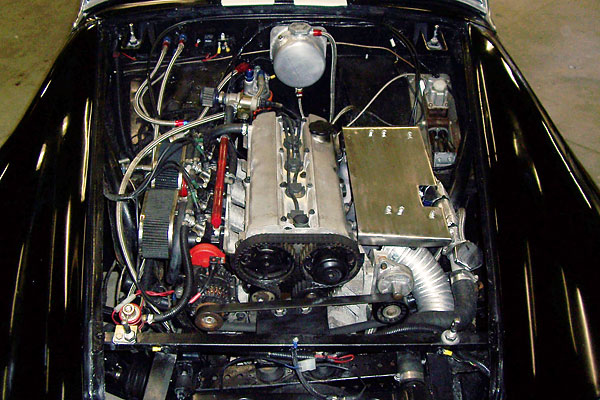
�
Ford Zetec 2.0L DOHC (1999 Mercury Cougar) with Webcon Alpha Gold induction/engine management.
�
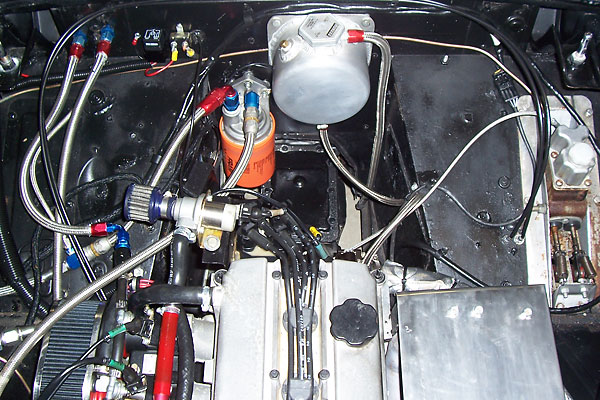
�
Fram HP-1 remote oil filter with Aeroquip braided lines. Aluminum coolant tank.
�
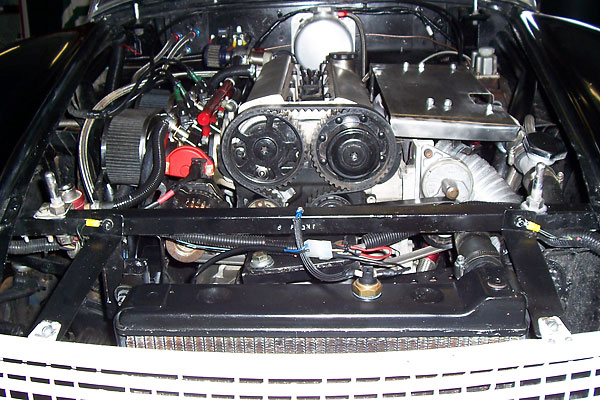
�
Stainless steel exhaust heat shield.
�
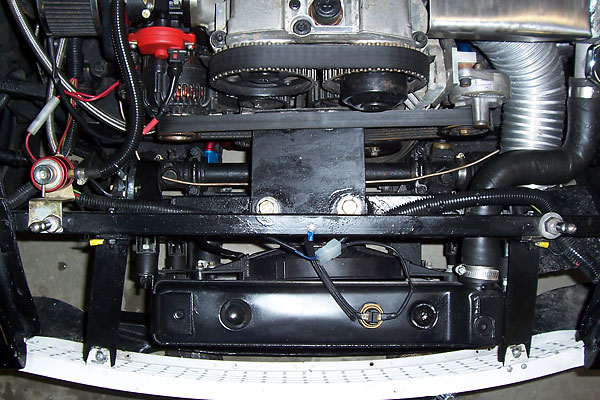
�
Caterham Super-7 radiator and electric fan.
�
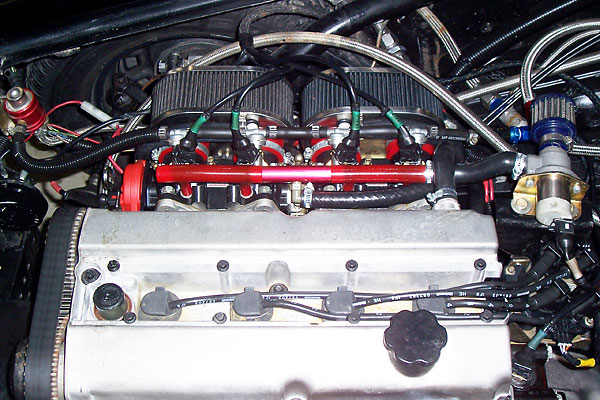
�
45mm throttle bodies. Pico fuel injectors.
�
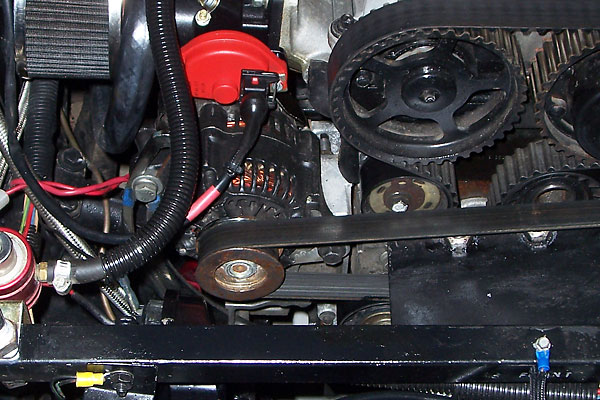
�
High output one-wire mini alternator mounted on custom brackets.
�
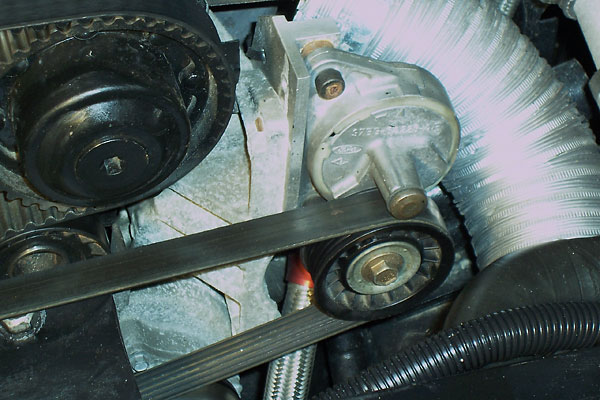
�
Lotus engine idler system and serpentine accessory drive belt.
�
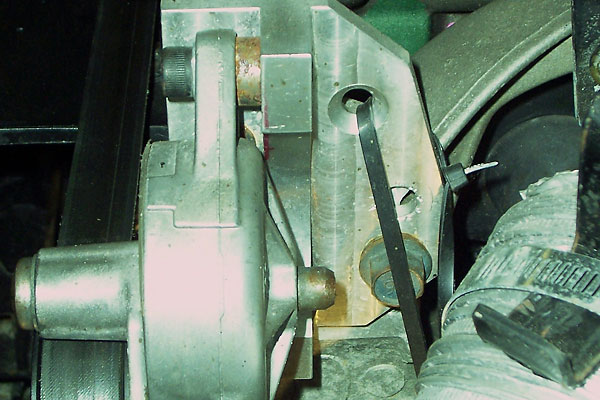
�
Side view of Lotus idler pulley.
�
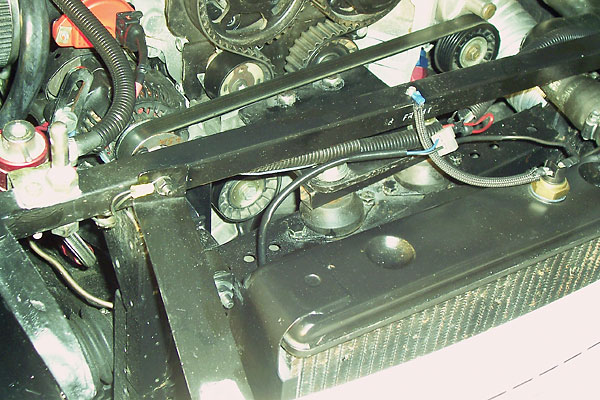
�
Custom front crossmember with Caterham motor mounts.
�
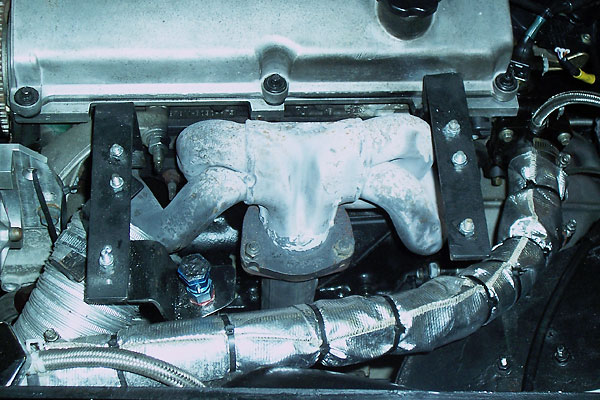
�
Modified Ford Focus header.
�
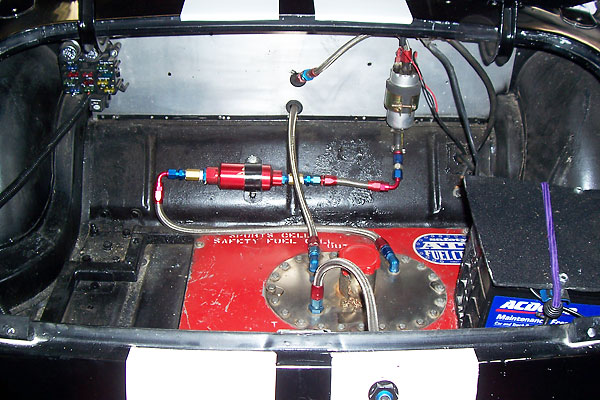
�
ATL Fuel Cell, filler foam, and anti-tip valve.
�
Suspension Details
��
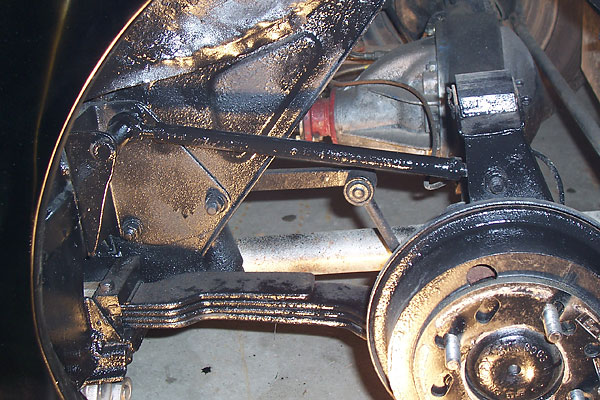
�
Offset racing-spec leaf springs and rose-jointed radius arms.
�
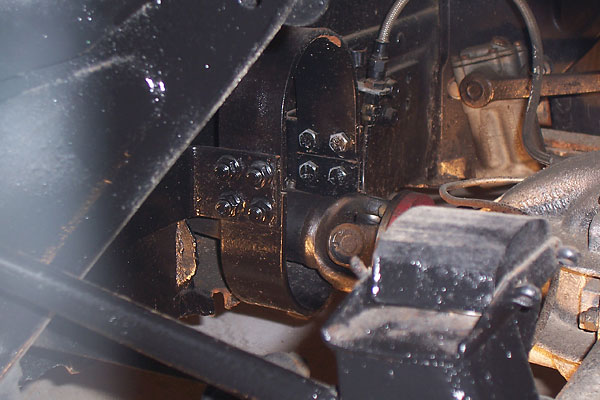
�
Custom driveshaft (29.25 inches long) with safety hoop.
�
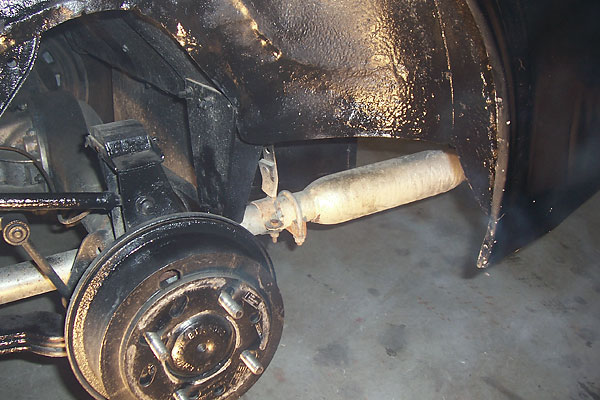
�
Stock Sprite drum brakes, and custom 1-7/8 exhaust system.
�
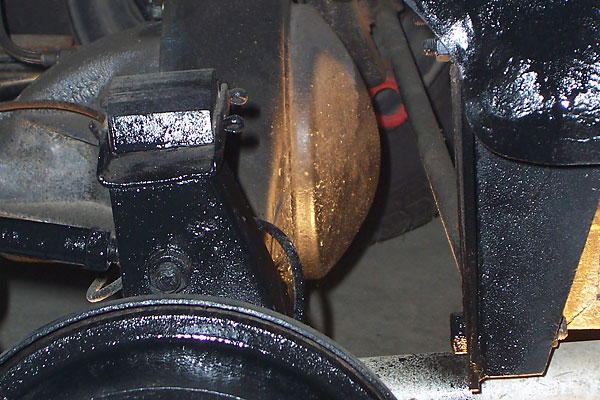
�
Custom Panhard bar.
�
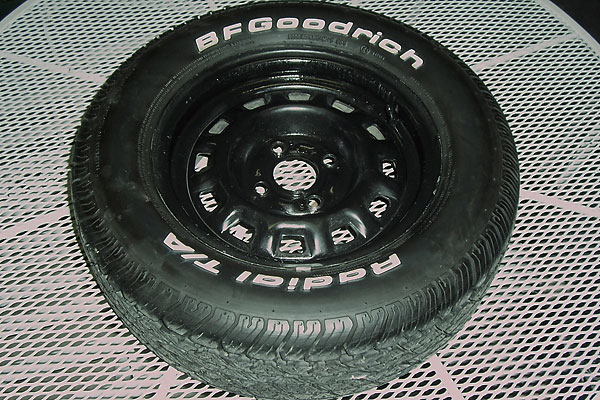
�
Chevrolet Vega 13x5 steel wheels with BF Goodrich Radial T/A 205/50 tires.
�
�
Enjoying this article? Our magazine is funded through the generous support of readers like you!
�
To contribute to our operating budget, please click here and follow the instructions.
�
(Suggested contribution is twenty bucks per year. Feel free to give more!)�
Interior
��
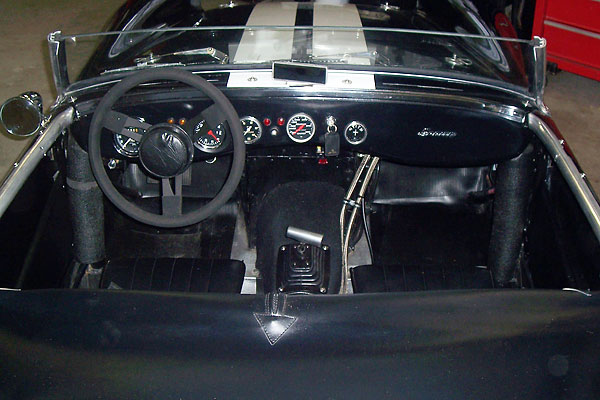
�
The cowl hoop from the old roll cage is hidden behind the instrument panel.
�
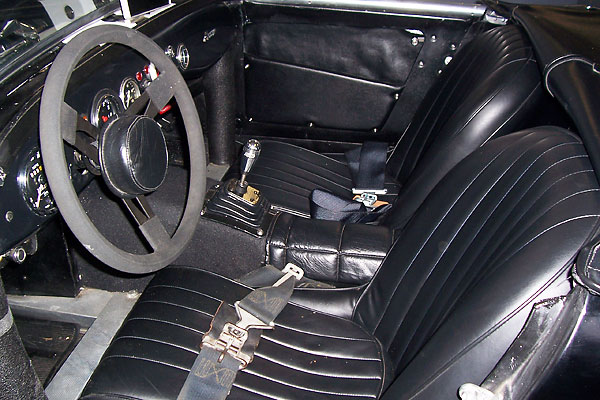
�
Cobra bucket seats with Simpson competition seat belts.
�
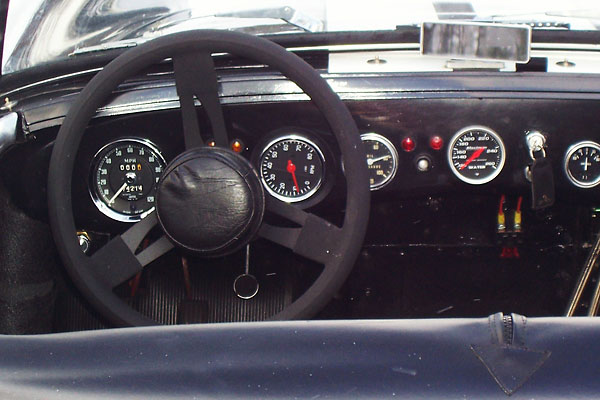
�
Stewart Warner gauges except Smiths MGB speedometer (120mph top instead of 100).
�
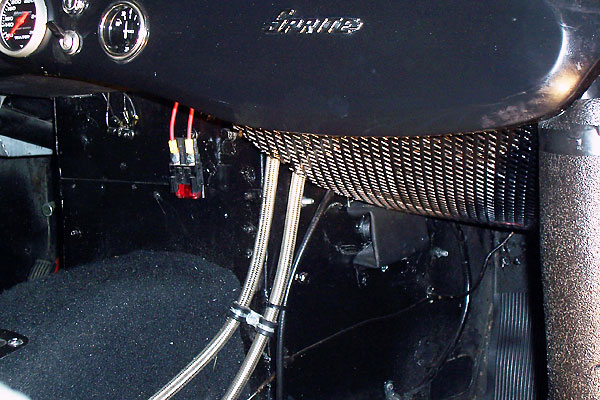
�
The engine ECU is located under the instrument panel on the passenger's side.
�
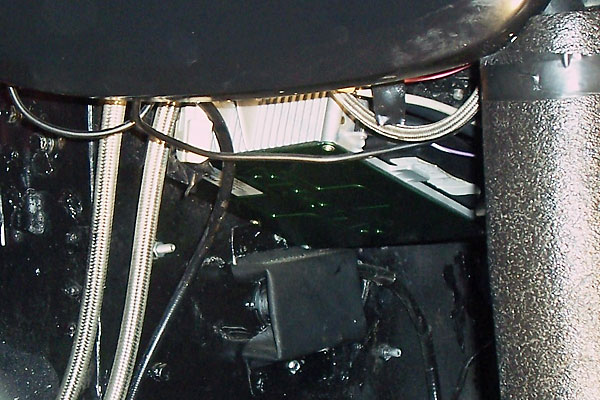
�
A screen protects the ECU and wiring.
�
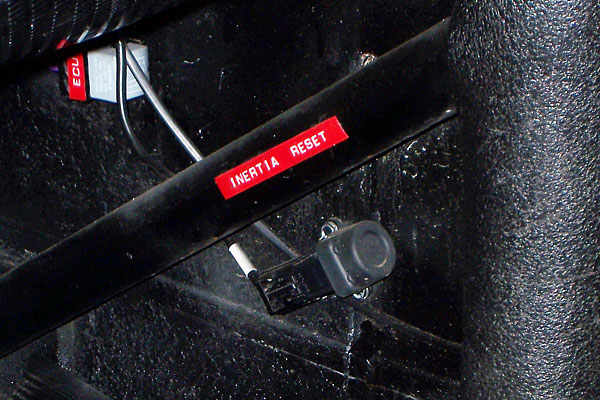
�
Inertia switch for the fuel pump is located in passenger's footwell.
�
Exterior
��
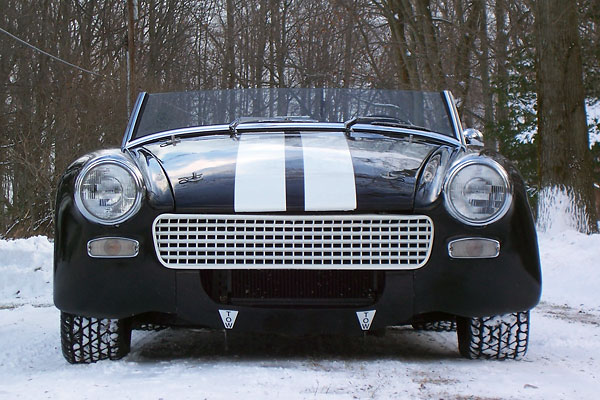
�
Fiberglass hood, front fenders and valance (with enlarged air inlet and filled bumper holes.)
�
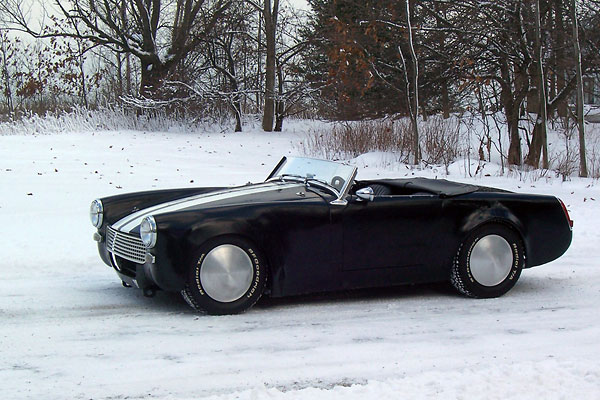
�
The windshield has been chopped 4.5 inches, and the top trim has been removed.
�
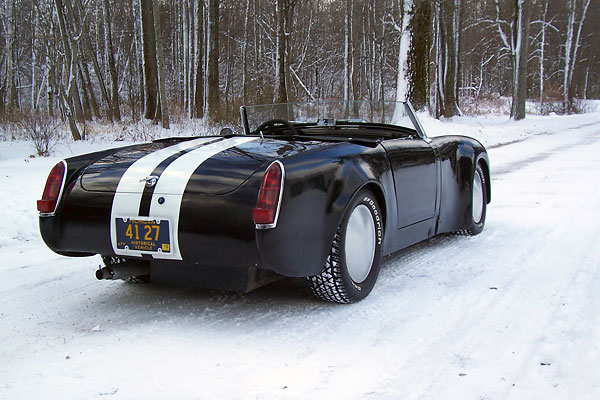
�
Fiberglass rear fenders with generously sized flares complete the racecar look.
�

